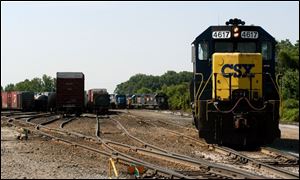
CSX abandons plan to close sorting yard
7/10/2004
CSX's Stanley Yard is reopened to deal with rail car congestion from a rise in sorting work at other yards. Some trains have waited on main lines and blocked crossings.
CSX Transportation Corp.'s attempt at closing one of its two Lake Township freight-car sorting yards has ended - at least for the time being.
Last week, the railroad reactivated the gravity-sorting hump at Stanley Yard, which was closed on April 1 in an economy move.
The hump facility's restart continued a gradual increase in activity at the yard that began almost immediately following its initial shutdown, though for weeks the yard officially remained closed.
During those weeks, train traffic on CSX slowed to a crawl in the region, with neighboring Walbridge Yard and nearby yards in Detroit, Willard, Lima, and elsewhere evidently overwhelmed by the workloads shifted to them.
As the yards overflowed, trains were parked on the main lines outside them, sometimes blocking crossings - and, in at least one case, the Maumee River - for hours.
"We understand when there's a train coming, and we have to wait. But a train just sitting there, there's no excuse for that," said Karl Busam, master of the charter sailing vessel Red Witch, which had to dock at the U.S. Coast Guard's Toledo station on a recent Saturday night because a CSX train was parked on a Maumee River drawbridge for nearly seven hours. More than 30 members of that night's charter group ended up sharing taxicabs to get back to their cars in downtown Toledo.
"I've been getting quite a few complaints. It seems to be a problem more recently," city Councilman Bob McCloskey, whose district includes East Toledo, said concerning streets blocked by trains. "Consaul, Seaman, in that area is where I've been getting a majority of my complaints."
The Stanley Yard reopening should provide relief, if only to open up more places where
trains can park without blocking the main line until their turn to be sorted arrives.
Bob Sullivan, a CSX spokesman, said Stanley's reopening is "temporary, but we don't know exactly how long." After resuming hump sorting one shift per day last week, he said, the facility is working full time this week.
Gary Sease, another CSX spokesman, said the train congestion is not unique to northwest Ohio. He also said that local railroad officials have been instructed to make sure the drawbridge blockage is not repeated.
"It's not just the Toledo area," he said. "Systemwide, we are seeing a lot of train traffic. Capacity issues are coming to the fore. It would be a good-news story, except it's creating congestion."
But Toledo is bearing more of the burden than most communities. Recent statistics that CSX has supplied to the Association of American Railroads suggest that its Toledo-area yards are now the most congested in all of North America.
During the last full week of June, a typical railcar took 61 1/2 hours to be sorted on CSX here, nearly double the time such a sort took at this time last year. The May average was 51.2 hours.
Other major yards nearby are starting to feel the effects of work transferred to them. CSX's sorting time at Cincinnati has ballooned from an average 42 1/2 hours in May to 60.8 hours during the last week of June. Facilities in Indianapolis, Louisville, Russell, Ky., and Willard are all among the system's slowest.
When freight cars linger longer in the yards, tracks to receive arriving trains fill up. With no place to go, those trains' crews may be instructed to park on the main lines, or on any other available tracks outside the yards. And if the decision to park the train occurs just as the crew's federal duty-time limit of 12 hours per shift is expiring, legally the crew can't move it to clear any crossings - or bridges - they might be blocking.
The situation feeds on itself because once parked trains occupy main line tracks or sidings, trains that still have crews on them take longer to get where they're going and may not be able to finish their runs within the legal 12 hours. And the locomotives on trains stranded in remote areas become unavailable for their next assignments, making it harder to clear space in the yards.
Using two or more crews to move a train over a distance usually accomplished by one also leaves the railroad short of workers.
The crew on the train that blocked the Maumee River bridge on the night of June 12 was expecting to be able to proceed beyond the Ironville junction in nearby East Toledo that evening, but was delayed there - either by trains ahead or trains crossing on an intersecting Norfolk Southern line - long enough that its 12 hours expired, Mr. Sullivan said. A replacement crew wasn't available until early the next morning.
According to Lt. Cmdr. Mark Skolnicki, a spokesman for the Coast Guard's Toledo station, the railroad faces a fine of up to $1,100 for failing to provide a requested bridge opening.
Cathy Mott, president of the Birmingham Neighborhood Coalition and a lifelong East Toledo resident, said blocked streets are frustrating and suggest the railroad doesn't care about how it affects ordinary people.
"When they stop, we have no idea how long they'll sit there. We understand that the rails have to run. We're reasonable people. But we would like some modicum of predictability," Ms. Mott said.
Along with reopening Stanley Yard, CSX is hiring 1,400 train-service employees, Mr. Sease said. The railroad also is gradually implementing a revised operating plan that it hopes will relieve chokepoints on its system.
Contact David Patch at:
dpatch@theblade.com
or 419-724-6094.